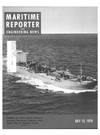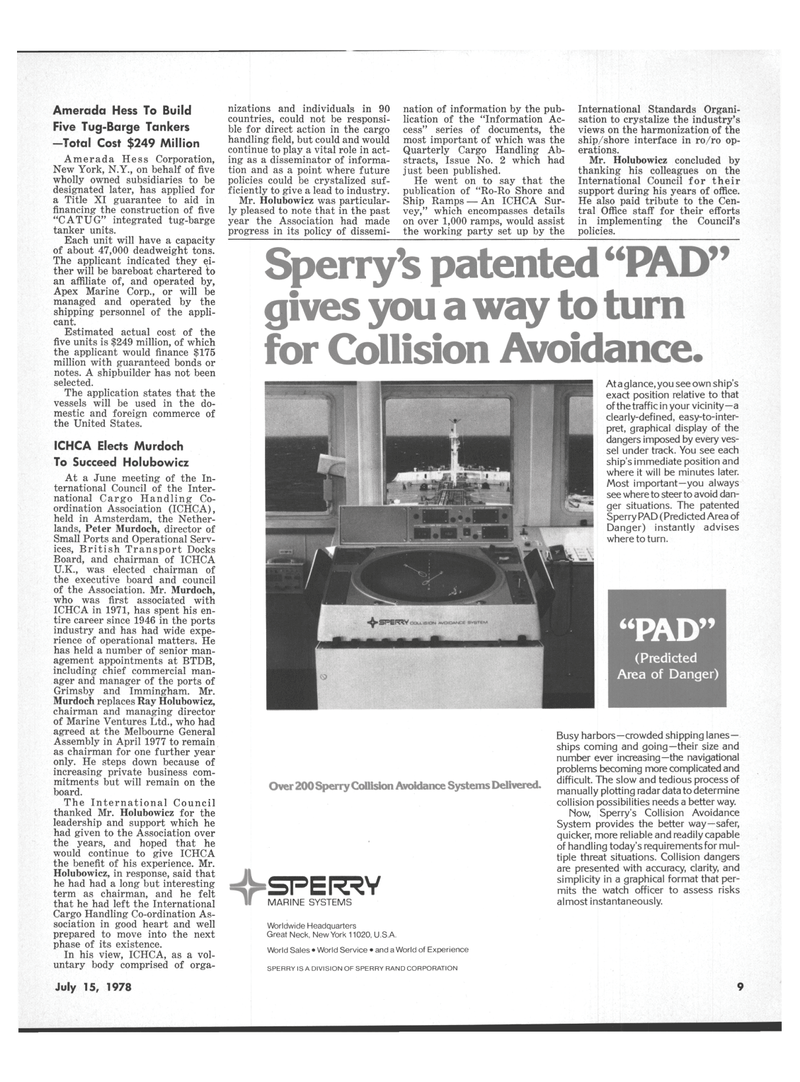
Page 7: of Maritime Reporter Magazine (July 15, 1978)
Read this page in Pdf, Flash or Html5 edition of July 15, 1978 Maritime Reporter Magazine
Amerada Hess To Build
Five Tug-Barge Tankers —Total Cost $249 Million
Amerada Hess Corporation,
New York, N.Y., on behalf of five wholly owned subsidiaries to be designated later, has applied for a Title XI guarantee to aid in financing the construction of five "CATUG" integrated tug-barge tanker units.
Each unit will have a capacity of about 47,000 deadweight tons.
The applicant indicated they ei- ther will be bareboat chartered to an affiliate of, and operated by,
Apex Marine Corp., or will be managed and operated by the shipping personnel of the appli- cant.
Estimated actual cost of the five units is $249 million, of which the applicant would finance $175 million with guaranteed bonds or notes. A shipbuilder has not been selected.
The application states that the vessels will be used in the do- mestic and foreign commerce of the United States.
ICHCA Elects Murdoch
To Succeed Holubowicz
At a June meeting of the In- ternational Council of the Inter- national Cargo Handling Co- ordination Association (ICHCA), held in Amsterdam, the Nether- lands, Peter Murdoch, director of
Small Ports and Operational Serv- ices, British Transport Docks
Board, and chairman of ICHCA
U.K., was elected chairman of the executive board and council of the Association. Mr. Murdoch, who was first associated with
ICHCA in 1971, has spent his en- tire career since 1946 in the ports industry and has had wide expe- rience of operational matters. He has held a number of senior man- agement appointments at BTDB, including chief commercial man- ager and manager of the ports of
Grimsby and Immingham. Mr.
Murdoch replaces Ray Holubowicz, chairman and managing director of Marine Ventures Ltd., who had agreed at the Melbourne General
Assembly in April 1977 to remain as chairman for one further year only. He steps down because of increasing private business com- mitments but will remain on the board.
The International Council thanked Mr. Holubowicz for the leadership and support which he had given to the Association over the years, and hoped that he would continue to give ICHCA the benefit of his experience. Mr.
Holubowicz, in response, said that he had had a long but interesting term as chairman, and he felt that he had left the International
Cargo Handling Co-ordination As- sociation in good heart and well prepared to move into the next phase of its existence.
In his view, ICHCA, as a vol- untary body comprised of orga- nizations and individuals in 90 countries, could not be responsi- ble for direct action in the cargo handling field, but could and would continue to play a vital role in act- ing as a disseminator of informa- tion and as a point where future policies could be crystalized suf- ficiently to give a lead to industry.
Mr. Holubowicz was particular- ly pleased to note that in the past year the Association had made progress in its policy of dissemi- nation of information by the pub- lication of the "Information Ac- cess" series of documents, the most important of which was the
Quarterly Cargo Handling Ab- stracts, Issue No. 2 which had just been published.
He went on to say that the publication of "Ro-Ro Shore and
Ship Ramps —An ICHCA Sur- vey," which encompasses details on over 1,000 ramps, would assist the working party set up by the
International Standards Organi- sation to crystalize the industry's views on the harmonization of the ship/shore interface in ro/ro op- erations.
Mr. Holubowicz concluded by thanking his colleagues on the
International Council for their support during his years of office.
He also paid tribute to the Cen- tral Office staff for their efforts in implementing the Council's policies.
Ata glance, you see own ship's exact position relative to that of the traffic in your vicinity—a clearly-defined, easy-to-inter- pret, graphical display of the dangers imposed by every ves- sel under track. You see each ship's immediate position and where it will be minutes later.
Most important—you always see where to steer to avoid dan- ger situations. The patented
Sperry PAD (Predicted Area of
Danger) instantly advises where to turn. "PAD" (Predicted
Area of Danger)
Sperry's patented "PAD gives you a way to turn for Collision Avoidance.
Over 200Sperry Collision Avoidance Systems Delivered.
Worldwide Headquarters
Great Neck, New York 11020, U.S.A.
World Sales • World Service • and a World of Experience
SPERRY IS A DIVISION OF SPERRY RAND CORPORATION
Busy harbors—crowded shipping lanes- ships coming and going—their size and number ever increasing—the navigational problems becoming more complicated and difficult. The slow and tedious process of manually plotting radar data to determine collision possibilities needs a better way.
Now, Sperry's Collision Avoidance
System provides the better way—safer, quicker, more reliable and readily capable of handling today's requirements for mul- tiple threat situations. Collision dangers are presented with accuracy, clarity, and simplicity in a graphical format that per- mits the watch officer to assess risks almost instantaneously.
July 15, 1978 9

 6
6

 8
8
